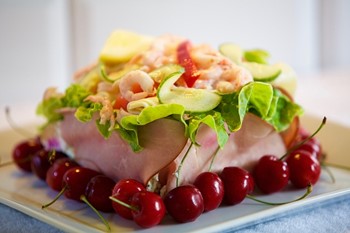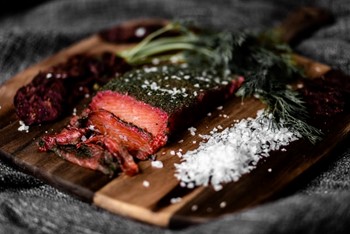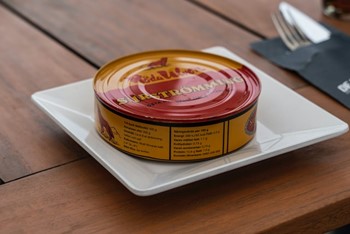Try delicious traditional Swedish food
One of the best parts of travelling is discovering and learning about different cultures. A great way to do this is by trying out some of the traditional local food. Classic Swedish cooking is about more than just wholesome and comforting flavours, it’s also about the company you share the food with. Are you ready to try some of these delightful mouthfuls?
 Fika
Fika
A must during any trip to Sweden, Fika is often translated as a coffee and cake break. But it is much more than that. Fika is a concept, a state of mind, an attitude and an important part of Swedish culture. Making time for fika is considered important to many Swedes. It means making time for friends and colleagues to share a cup of coffee (or tea) and a little something to eat.
You can enjoy fika in most cafés and even during boat tours, such as the Royal Bridges and Canal tour. Take the time to sit back, relax and enjoy your time with those around you. Having a stunning view to enjoy along the way will only improve the experience.
Toast Skagen
This Swedish classic is often served as a starter in restaurants and has come to symbolise elegance in Swedish food. Toast Skagen was created in the late 1950s by chef-restaurateur Tore Wretman and named after a Danish fishing port. It is a piece of sautéed bread topped with prawns, whitefish roe, Dijon mustard, mayonnaise and a sprig of dill.
Restaurants often advertise their Toast Skagen to have handskalade räkor (hand shelled prawns). This is a big selling point for Swedes, who believe that it doesn’t matter if the prawns are fresh or frozen as long as they have been hand shelled.
 Smörgåstårta
Smörgåstårta
This is the ultimate treat for those who love cake and sandwiches as it is basically a sandwich cake. While often served at festive occasions, you can also buy smaller pieces at cafés and grocery stores. There are two classics: Smörgåstårta with salmon and seafood and Smörgåstårta with roast beef, ham, and cheese.
If you are making a Smörgåstårta yourself, you don’t have to worry about what you want to put on there as there are no real rules. To avoid the cake being too dry, it’s filled with different things such as mayonnaise, egg, pate or creamy mixtures, and then decorated with meat and vegetables. The result is a centrepiece-worthy showstopper.
Potato dumplings
There are different names and different ways to make potato dumplings across Sweden, though the most common name is kroppkakor. In the north, where they are called pitepalt or just palt, and on the east coast island of Öland, where they call them öländska kroppkakor, the dumplings are made flour and raw potatoes. Whereas, in central and southern Sweden they are made with cooked potatoes.
The dumplings can be filled with anything that is at hand but there are two popular choices: onion and unsmoked bacon or fried wild mushrooms. They are often served as a main course but can also serve as a delicious side dish.
Meatballs
Swedish meatballs are known all around the world, or at least everywhere you can find an IKEA store. Köttbullar as they are known in Swedish are smaller and have a different flavour to Italian meatballs and are almost always served with a cream sauce. The first recipe for Köttbullar dates back to 1755, ever since these meatballs have been a Swedish favourite.
Today every Swede has their own variation of a meatball recipe. In Stockholm you’ll find that the meatballs contain more pork (fat) than the meatballs served in the north of the country. As well as the cream sauce, the meatballs are often served with potatoes and lingonberries.
 Gravad Lax
Gravad Lax
The name of this dill cured salmon dish translates to grave salmon and refers to the medieval practice of curing raw fish by salting it and then burying it in sand or with weights on top to force the salt into the fish. Gravad lax is one of Sweden’s most famous dishes and has travelled far beyond the country’s borders.
It is usually served with mustard sauce and it is a staple on the traditional smorgasbord. You can even make it yourself though it will take a few days. Essentially some salt is rubbed into salmon to cure it and then some sugar, pepper and dill is added for flavour. The fish is then weighted down in a fridge for 48 hours to force the salt and flavours into the salmon.
Korv Stroganoff
While this dish shares part of its name with the classic Russian beef-based dish, the Swedish korv stragonoff is quite unlike the Russian meal. The only similarities are the spiciness of the sauce, seasoned with paprika, the cream and the onions.
Instead of beef, this korv stroganoff is based on the uniquely Swedish falukorv (a kind of smoked sausage), chopped tomatoes with a dollop of tomato puree and a sprinkle of chili. The dish is a favourite with Swedish teenagers and goes well with pasta or rice and a salad.
 Sill & Surströmming
Sill & Surströmming
Herring is a staple of Swedish cuisine, both pickled (sill) and fermented (surströmming). Pickled herring has a long history in Swedish food. At first this was because herring was plentiful and cheap, today pickled herring is central to many Swedish festivals and feasts. For instance, it makes up the first course of a julbord (Christmas buffet).
Surströmming is possibly the smelliest food you can try in Sweden. The Swedes save it for summer, so it can be enjoyed outside instead of stinking up the house. The fermented herring is especially popular in northern Sweden but can also be enjoyed in shops and restaurants around Stockholm from the third Thursday of August.
